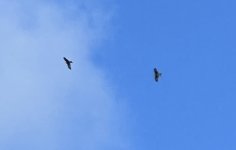MohoNobilis
Member

Haven't been active on here much, but I am very glad to say that I have been birding constantly over the past few weeks, and that I would gladly wake up early in the morning just to see the birds around my school campus.
Since I was gone, I have seen many different types of birds that are new to me (since I am not from the UK) - from the tiny goldcrest to noisy Eurasian oystercatchers and a nuthatch that apparently settled down in the school grounds.
Going out more often also means that I am starting to notice more than what others might see as common birds around the area. As a student who is fascinated by birds, I am always grateful even when any robin or blackbird shows up in front of me (only to quickly run or fly away after making a short amount of eye contact).
Recently, I have gained an interest in birds of prey. Ever since I have seen my first red kite on the campus in February, I have always waited to see more of them around here.
Just a few days ago, I have seen two red kites flying in the sky. What made me stare at them in awe was how they glided in sync - as if they were carefully coordinated. I have no idea as to why they might do that (as I am just a student who has recently gained this interest in birding), but it was a rather fascinating sight to watch.

The next day, I found a broken feather on the ground. It was quite long compared to the size of my hand, and I didn't know what bird it belonged to. I felt strangely connected to it after picking it up, however. I only kept a half of it due to the other half being unsalvageable.

(Size of feather segment, hand for reference.)
All stuff about that feather aside, it was quite nice to finally go outside and get closer to nature without being looked at by other people who don't fully understand the beauty of such little things around my school. England is such a wonderful place for birding, and I'm glad that I got to know more about the birds around my area in these few months.
Since I was gone, I have seen many different types of birds that are new to me (since I am not from the UK) - from the tiny goldcrest to noisy Eurasian oystercatchers and a nuthatch that apparently settled down in the school grounds.
Going out more often also means that I am starting to notice more than what others might see as common birds around the area. As a student who is fascinated by birds, I am always grateful even when any robin or blackbird shows up in front of me (only to quickly run or fly away after making a short amount of eye contact).
Recently, I have gained an interest in birds of prey. Ever since I have seen my first red kite on the campus in February, I have always waited to see more of them around here.
Just a few days ago, I have seen two red kites flying in the sky. What made me stare at them in awe was how they glided in sync - as if they were carefully coordinated. I have no idea as to why they might do that (as I am just a student who has recently gained this interest in birding), but it was a rather fascinating sight to watch.

The next day, I found a broken feather on the ground. It was quite long compared to the size of my hand, and I didn't know what bird it belonged to. I felt strangely connected to it after picking it up, however. I only kept a half of it due to the other half being unsalvageable.

(Size of feather segment, hand for reference.)
All stuff about that feather aside, it was quite nice to finally go outside and get closer to nature without being looked at by other people who don't fully understand the beauty of such little things around my school. England is such a wonderful place for birding, and I'm glad that I got to know more about the birds around my area in these few months.





